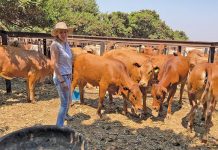
Mastitis is the most costly and common disease in a dairy farming enterprise. Undetected at a subclinical level, it may not be effectively prevented or controlled. Profit loss, while often not quantified, is real and may mean the difference between the success or failure of a dairy operation.
“Udder health directly influences the quantity and quality of milk produced by a dairy farm. Mastitis causes significant losses through reduced milk production and lower milk quality. Yet even South Africa’s top dairy farmers all too often don’t understand mastitis properly,” says Dr Vincent Turner, a former professor at Onderstepoort, now a private consultant in udder health and preventive medicine.
Mastitis is an inflammation of the milk producing tissue of the udder. It is caused by bacterial infection, trauma or injury, and presents either as subclinical or clinical mastitis. Subclinical mastitis is not noticeable to the naked eye while clinical mastitis presents as swollen, painful udders with an abnormal milk secretion. Any increase in somatic cell counts (SCC), which is a normal constituent of cows’ milk at a rate of about 100 000 cells/ ml in bulk herd milk is caused by compromised udder health.

Dr Vincent Turner
Subclinical mastitis is the most common and significant cause of an elevated SCC. “Many farmers tend to be concerned only with the clinical forms of mastitis but subclinical mastitis is far more common. It is often underestimated because it goes undetected and cannot be diagnosed directly on the farm,” says Dr Turner.
One way of determining the financial health of a dairy enterprise is by measuring the amount of good quality milk produced. Milk buyers pay a premium for milk with a low SCC, but milk production cannot be optimised from cows chronically infected with subclinical mastitis due to the hidden lesions damaging the milk-secreting tissue of the udder. These factors combine to put a significant dent in the milk cheque. For example, an udder quarter chronically infected with subclinical mastitis and with an SCC of 300 000 cells/ml will lead to a 6% average loss of potential milk production.

Gangrenous mastitis caused by Staphylococcus aureus shows the typical bluish colour of the affected quarters, which are cold and moist to the touch. Antoni Foix, HIPRA
Similarly, a quarter with an SCC of 900 000 cells/ ml can reduce potential milk production by 19%, says Dr Turner. The economic losses associated with mastitis have been calculated by a number of leading scientists. In general, losses due to clinical mastitis and cost of treatment amount to 1% of total financial loss due to mastitis, while reduced milk production and discarded milk amounts to 5% and death and premature culling amounts to 12%.
Loss due to subclinical mastitis is approximately 82% of estimated total financial loss caused by mastitis. “This loss is as a result of reduced milk production and decreased milk quality,” he says. Many farmers and vets attempt to solve udder health problems with antibiotics. However, this is not the solution. “Firstly, antibiotics have no effect on somatic cells and can only be used against bacteria. Secondly, antibiotic treatment against bacterial mastitis is often unsuccessful.”
A new vaccine marketed by Hipra Southern Africa, which could offer additional aid to combating mastitis, is currently being tested on South African dairy herds says Dr Turner. “However, there is no quick fix. The only way to combat these problems effectively is by implementing adequate control and preventive measures on a continuous basis.”

This Holstein cow presents a healthy looking udder. The top producers in the herd are often more susceptible to mastitis. Robyn Joubert
Dr Turner uses the case of a dairy farmer in the KZN Midlands with a 600-cow milking herd to illustrate his point. When the Bulk Milk SCC (BMSCC) increased to over 500 000 cells/ml accompanied by an increase in the number of cases of clinical mastitis, Dr Turner was called in. While mastitis is usually caused by many factors, in this case the culprit was a specific bacteria.
“The overall management of the herd was very good. It included regular six-monthly servicing of the milking machine and good hygiene in the parlour. On further investigation, it was found that the main problem was Staphyloccocus aureus, from chronically infected cows.” The farmer implemented stringent control measures to prevent the situation from worsening. One hundred chronically infected animals were identified and were either culled or moved to another farm.
“He then had 500 animals with excellent udder health and within five months the BMSCC was down to 247 000 cells/ ml. He started earning a premium of 9c/l to 10c/l for his milk. Instead of losing R30 000/month for high SCCs, he recovered his loss and earned an additional R30 000 a month,” says Dr Turner.
Causes of mastitis
A number of key management issues need to be addressed to maintain udder health. These include fly control, correct nutrition, personnel training, sterilisation, servicing the milking machine, and the identification of problem animals. “Flies play a significant role in poor udder health. They are efficient vectors of disease and can transmit mastitis-causing bacteria (mastitogens) such as Staphyloccocus aureus, E. coli and Streptococcus uberis.
They also cause irritation and the continued stress results in reduced milk production and an increase in the SCC. Biting flies can cause irritable reaction and stress with accompanying udder health problems. They may transmit diseases such as anaplasmosis and Rift Valley fever,” says Dr Turner.
Fly problems are preventable and fly management should be part of any udder health programme. Best management practices include cleanliness, good drainage and the constant removal of manure and organic matter from around the parlour and calf rearing areas to eliminate potential fly-breeding areas. Predatorial wasps, bait and knock-down sprays will also help control fly populations.
Udders are a direct source of the farmer’s monthly income so a comprehensive udder health programme is essential in any dairy herd health programme. “This includes monitoring the udder health status of individual cows and systematic, cost-effective laboratory testing of milk samples from appropriately selected cows,” says Dr Turner. In the current economic climate, dairymen understandably cut costs wherever possible. But cost-cutting should not have an adverse effect on the procedures used to promote and protect udder health.
Where possible, dairy farmers should calculate the losses associated with mastitis to determine whether the udder health of the herd is within acceptable limits. “Costs should be calculated for a year. No business can be managed successfully on penalties and this is especially true for dairy farming. Dairy farmers should aim to obtain whatever premium prices their milk buyers offer,” Dr Turner concludes.
Contact: Dr Vincent Turner, 031 765 7075; 083 268 5711; [email protected]













